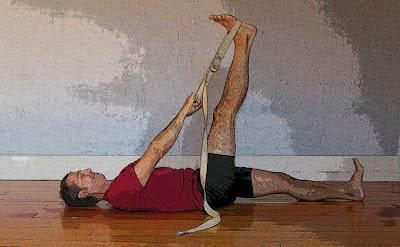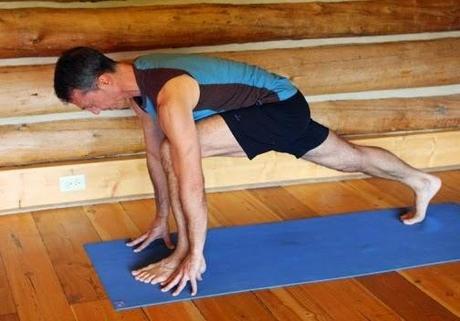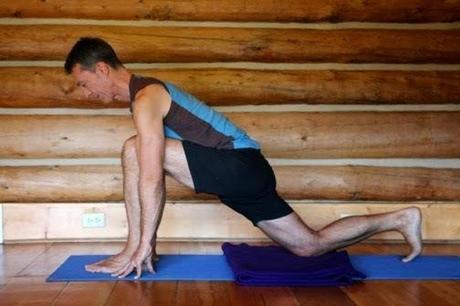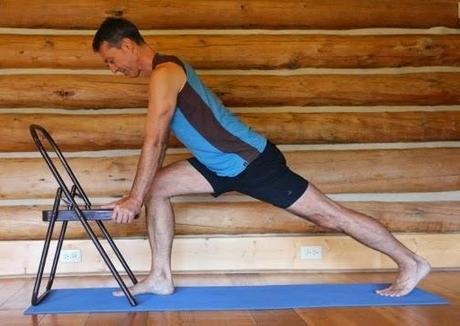 Q: I have a question that may relate to the sitting theme. For those people who cannot straighten up, walking with flexed hips, what are the first actions/muscles to both strengthen and lengthen? It seems I see many older people with this jackknifed posture and would like to help address it. Thank you!A: I see these people, too, in the neighborhood near Piedmont Yoga Studio in Oakland. There are several high-rise retirement buildings in the area, and a lot of the residents are out and about on busy Piedmont Ave during the day, doing errands and getting some activity in. I am amazed by some of the postural changes I observe in some of these men and women. Not only do they seem to be flexed at the hip joint, but there usually there is also a pretty noticeable increase in the normal curve of the upper back area, which is referred to as “kyphosis.” This kyphosis of the thoracic spine can cause a corresponding collapse of the front chest. (See Friday Q&A: Kyphosis for information on kyphosis and dowager’s hump.) One of the main things I worry about for these folks is the limitation in their ability to stand up straight enough to see around their environment well, as their posture tends to leave them looking down at the ground and not very far in front of the themselves. If you happen to be dealing with such changes in your body, on a small or large scale, or if you work with older students in your classes, here are a few things to consider:1. Working on improving mobility at the hip joint is likely going to be easier and safer to address before the upper chest (more on that in a bit). A good starting place is to try some reclining hip movements, such as our Dynamic Reclined Hip Stretches series. If getting down on the floor is not possible, you can even do these while lying in bed.
Q: I have a question that may relate to the sitting theme. For those people who cannot straighten up, walking with flexed hips, what are the first actions/muscles to both strengthen and lengthen? It seems I see many older people with this jackknifed posture and would like to help address it. Thank you!A: I see these people, too, in the neighborhood near Piedmont Yoga Studio in Oakland. There are several high-rise retirement buildings in the area, and a lot of the residents are out and about on busy Piedmont Ave during the day, doing errands and getting some activity in. I am amazed by some of the postural changes I observe in some of these men and women. Not only do they seem to be flexed at the hip joint, but there usually there is also a pretty noticeable increase in the normal curve of the upper back area, which is referred to as “kyphosis.” This kyphosis of the thoracic spine can cause a corresponding collapse of the front chest. (See Friday Q&A: Kyphosis for information on kyphosis and dowager’s hump.) One of the main things I worry about for these folks is the limitation in their ability to stand up straight enough to see around their environment well, as their posture tends to leave them looking down at the ground and not very far in front of the themselves. If you happen to be dealing with such changes in your body, on a small or large scale, or if you work with older students in your classes, here are a few things to consider:1. Working on improving mobility at the hip joint is likely going to be easier and safer to address before the upper chest (more on that in a bit). A good starting place is to try some reclining hip movements, such as our Dynamic Reclined Hip Stretches series. If getting down on the floor is not possible, you can even do these while lying in bed.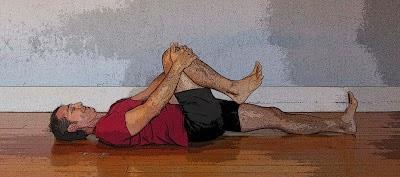 More specifically, the muscles at the front of the hip joint are certainly going to be tight and shortened, so gradually doing poses to lengthen these muscles, such as part of the quadriceps group as well as the psoas and iliacus, are a good starting place. Working on High and Low Lunge Pose (see Lunge Pose) addresses these areas nicely, and if your flexibility makes it hard to get into these poses as an able bodied student might, you can start with doing variations while sitting on a chair.
More specifically, the muscles at the front of the hip joint are certainly going to be tight and shortened, so gradually doing poses to lengthen these muscles, such as part of the quadriceps group as well as the psoas and iliacus, are a good starting place. Working on High and Low Lunge Pose (see Lunge Pose) addresses these areas nicely, and if your flexibility makes it hard to get into these poses as an able bodied student might, you can start with doing variations while sitting on a chair.
High Lunge
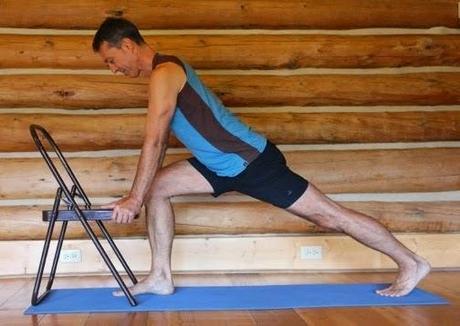
High Lunge with Chair
Low Lunge
And, in all likelihood, the muscles at the backs of hips and legs are going to be tight as well, so doing Reclined Leg Stretch pose to work on lengthening the hamstrings, gluteal muscles, and calves should help as well.